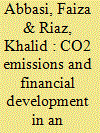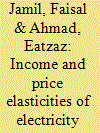|
|
|
Sort Order |
|
|
|
Items / Page
|
|
|
|
|
|
|
| Srl | Item |
| 1 |
ID:
150824


|
|
|
|
|
| Summary/Abstract |
This paper explores the influence of economic and financial development on carbon emissions in a small emerging economy. The study employs ARDL approach to investigate the long run relationship between carbon emissions and a set of economic and financial variables, an Error Correction Model (ECM) to capture the short run dynamics, Granger causality in an augmented VAR framework to check the causality direction, and variance decomposition based on an estimated Vector Error Correction Model (VECM) to determine the relative contributions of economic and financial variables to the evolution of per capita carbon emissions. The periods considered were the full sample (1971–2011), and a reduced sample sub-period (1988–2011) that corresponded to greater liberalization and financial sector development. The financial variables played a role in emission mitigation only in the latter period where greater degree of liberalization and financial sector development occurred. Even then the relative magnitude of emissions mitigation attributable to financial variables was much smaller compared to the emissions raising impact of rising per capita incomes. This underscores the need for adopting other mitigation policies for reducing carbon footprints in those emerging economies where a sufficient degree of financial deepening and financial sector development has not yet taken place.
|
|
|
|
|
|
|
|
|
|
|
|
|
|
|
|
| 2 |
ID:
122455


|
|
|
|
|
| Publication |
2013.
|
| Summary/Abstract |
Tourism is one of the largest and fastest growing industries in the world, which makes it a potential strategic factor for economic growth. This adds to the strong interest in the role of tourism in Malaysia's economic growth as it is the second-largest contributor to foreign exchange earnings after manufacturing. In addition, empirical results associated with Granger causality among economic growth, tourism and exports within the neoclassical framework are inconsistent. The objectives of this study, thus, are to determine: the long-run relationship; the long-run and short-run Granger causality; and the long-run triangular Granger causality between economic growth and tourism receipts corresponding to selected macroeconomic variables such as government tourism expenditure, physical capital, education, health and exports as control variables. The long-run Granger causality in vector error correction model (VECM) shows economic growth, tourism receipts and health complement each other (bidirectional causality), while unidirectional causalities are found between government tourism expenditure, physical capital, education and exports to economic growth. In addition, enhancing physical capital, education, health, exports and government tourism expenditure precede tourism receipts; all these in turn indirectly lead to economic growth, thus witnessing triangular relationships among them.
|
|
|
|
|
|
|
|
|
|
|
|
|
|
|
|
| 3 |
ID:
109435


|
|
|
|
|
| Publication |
2011.
|
| Summary/Abstract |
Cointegration and vector error correction modeling approaches are widely used in electricity demand analysis. The study rigorously examines the determinants of electricity demand at aggregate and sectoral levels in Pakistan. In the backdrop of severe electricity shortages, our empirical findings give support to the existence of a stable long-run relationship among the variables and indicate that electricity demand is elastic in the long run to both income and price at aggregate level. At sectoral level, long-run income and price elasticity estimates follow this pattern except in agricultural sector, where electricity demand is found elastic to output but inelastic to electricity price. On the contrary, the coefficients for income and price are rather small and mostly insignificant in the short run. We employed temperature index, price of diesel oil and capital stock at aggregate and sectoral levels as exogenous variables. These variables account for most of the variations in electricity demand in the short run. It shows that mechanization of the economy significantly affect the electricity demand at macro level. Moreover, elastic electricity demand with respect to electricity price in most of the sectors implies that electricity price as a policy tool can be used for efficient use and conservation.
|
|
|
|
|
|
|
|
|
|
|
|
|
|
|
|
| 4 |
ID:
092541


|
|
|
|
|
| Publication |
2009.
|
| Summary/Abstract |
This paper tries to answer the long-standing question of whether money causes output. Instead of focusing on domestic monetary policy and output, we analyze U.S. monetary policy and its possible effects on real output in China. Our results indicate that the main monetary instrument in the U.S., the Federal Fund Rate, Granger causes China's output. A second monetary variable, U.S. money supply, does not seem to have a significant effect on China's output. The results are supported by variance decompositions, which indicate that Federal Fund Rate shocks have an effect on China's real output. The findings have important implications for policy makers in China that focus on maintaining a high and stable economic growth.
|
|
|
|
|
|
|
|
|
|
|
|
|
|
|
|
| 5 |
ID:
098655


|
|
|
|
|
| Publication |
2010.
|
| Summary/Abstract |
This study analyzes the relationship among electricity consumption, its price and real GDP at the aggregate and sectoral level in Pakistan. Using annual data for the period 1960-2008, the study finds the presence of unidirectional causality from real economic activity to electricity consumption. In particular, growth in output in commercial, manufacturing and agricultural sectors tend to increase electricity consumption, while in residential sector, growth in private expenditures is the cause of rising electricity consumption. The study concludes that electricity production and management needs to be better integrated with overall economic planning exercises. This is essential to avoid electricity shortfalls and unplanned load shedding.
|
|
|
|
|
|
|
|
|
|
|
|
|
|
|
|
| 6 |
ID:
177322


|
|
|
|
|
| Summary/Abstract |
A sustainable energy mix leads to stable and long-term economic goals in which sectors play an essential role. Therefore, the study explores the relationship between electricity consumption (EC), electricity price (EP), and real GDP at the various sectors and general levels from the period 1970–2018 in Pakistan by using the Johansen Co-integration test and Vector Error Correction Model (VECM). The selected sectors are as follows; agricultural, commercial, industrial, and residential also cumulatively. Each sector regress with EC, EP, GDP, other electricity consumption (OEC), and urbanization population growth (UPG) determinants. The outcomes indicate the long-run relationship between industrial, residential sectors, and cumulative. However, commercial and agricultural sectors also revealed a long-run relationship, while feedback effects were found in EC and EP. Furthermore, the short-run causality found in all sectors except cumulative UPG to GDP, agricultural OEC to EP, commercial, EC to GDP, industrial UPG to EC, and UPG to GDP in residential whereas UPG strongly exogenous effect on the commercial and residential sector and OEC misuse causes the wastage of EC and increasing of price. The research findings could be beneficial for policymakers, and electricity management is essential to strengthening long-lasting economic policies.
|
|
|
|
|
|
|
|
|
|
|
|
|
|
|
|
| 7 |
ID:
087968


|
|
|
|
|
|
|
|